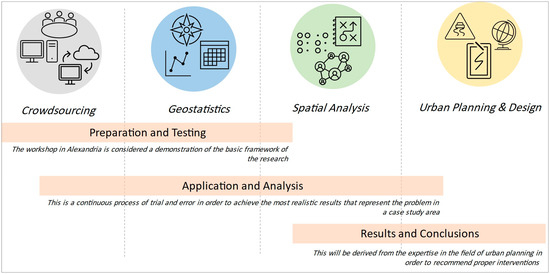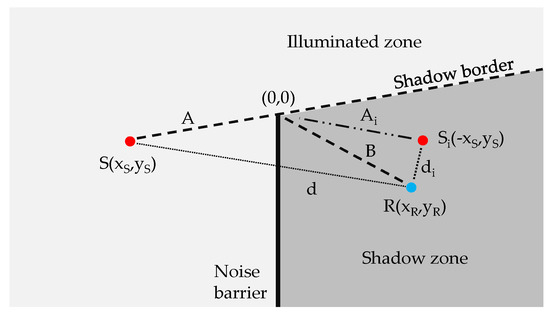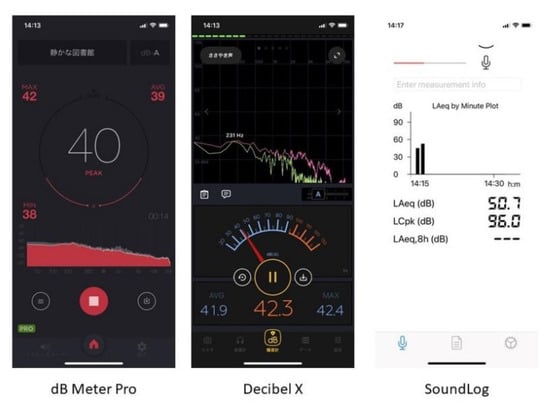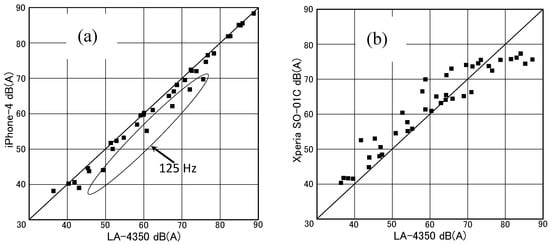Urban Acoustic Environments
A topical collection in Urban Science (ISSN 2413-8851).
Viewed by 20025
Share This Topical Collection
Editors
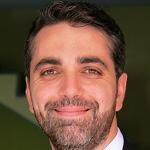 Dr. Francesco Aletta
Dr. Francesco Aletta
 Dr. Francesco Aletta
Dr. Francesco Aletta
E-Mail
Website
Collection Editor
UCL Institute for Environmental Design and Engineering, Bartlett School of Environment, Energy and Resources, University College London, London WC1H 0NN, UK
Interests: environmental acoustics; soundscape; community noise; noise annoyance; urban planning; environmental design; environmental assessment; landscape design
Special Issues, Collections and Topics in MDPI journals
 Dr. Jooyoung Hong
Dr. Jooyoung Hong
 Dr. Jooyoung Hong
Dr. Jooyoung Hong
E-Mail
Website
Collection Editor
School of Electrical & Electronic Engineering, Nanyang Technological University, Singapore 639798, Singapore
Interests: environmental acoustics; soundscape; building acoustics; urban planning virtual reality; multi-modal perception
Topical Collection Information
Dear Colleagues,
We are inviting submissions for the Topical Collection “Urban Acoustic Environments”, which aims to gather new research results dealing with the city realm and environmental sounds. The first studies investigating the relationships between the urban form and human experience of the acoustic environments date back to the Sixties. The quality of the outdoor acoustic environment has been a major community concern ever since, and the body of literature and multi-disciplinary research on the topic is growing. While the general approach to the management of environmental sounds has typically been a reactive one, more recent research and practice trends suggest that the aural domain should also be used proactively to promote healthy and supportive living spaces. Within this context, it is essential to embed “sound” into the broader framework of urban planning and design. For this reason, we have launched the call for this Topical Collection on the urban acoustic environment. It will include a collection of original research articles, reports or technical notes, and review papers on the following topics: i) the urban implications of environmental sounds, ii) the relationships between landscapes and soundscapes, iii) the associations between land use and the spatial distribution of sound sources, iv) the effects of urban morphology on sound propagation in urban contexts, v) new sound mapping techniques, vi) the use of virtual reality in urban sound planning, and vii) studies on any other methodological strategies to characterize urban acoustic environments, both quantitatively and qualitatively.
Dr. Francesco Aletta
Dr. Jooyoung Hong
Collection Editors
Manuscript Submission Information
Manuscripts should be submitted online at www.mdpi.com by registering and logging in to this website. Once you are registered, click here to go to the submission form. Manuscripts can be submitted until the deadline. All submissions that pass pre-check are peer-reviewed. Accepted papers will be published continuously in the journal (as soon as accepted) and will be listed together on the collection website. Research articles, review articles as well as short communications are invited. For planned papers, a title and short abstract (about 100 words) can be sent to the Editorial Office for announcement on this website.
Submitted manuscripts should not have been published previously, nor be under consideration for publication elsewhere (except conference proceedings papers). All manuscripts are thoroughly refereed through a single-blind peer-review process. A guide for authors and other relevant information for submission of manuscripts is available on the Instructions for Authors page. Urban Science is an international peer-reviewed open access quarterly journal published by MDPI.
Please visit the Instructions for Authors page before submitting a manuscript.
The Article Processing Charge (APC) for publication in this open access journal is 1600 CHF (Swiss Francs).
Submitted papers should be well formatted and use good English. Authors may use MDPI's
English editing service prior to publication or during author revisions.
Keywords
- environmental sounds
- community noise
- urban sound planning
- urban acoustics
- noise mapping
- quiet areas
- sound monitoring systems and acoustic sensors networks
- perception of urban sounds and soundscapes
- virtual/augmented reality and urban acoustics
Published Papers (6 papers)
Open AccessArticle
Investigating Noise Mapping in Cities to Associate Noise Levels with Sources of Noise Using Crowdsourcing Applications
by
Esraa Othman, Iva Cibilić, Vesna Poslončec-Petrić and Dina Saadallah
Viewed by 1433
Abstract
Environmental noise is a major environmental concern in metropolitan cities. The rapid social and economic growth in the 20th century is not always accompanied by adequate land planning and environmental management measures. As a consequence of rapid urbanization processes, cities are facing an
[...] Read more.
Environmental noise is a major environmental concern in metropolitan cities. The rapid social and economic growth in the 20th century is not always accompanied by adequate land planning and environmental management measures. As a consequence of rapid urbanization processes, cities are facing an increase in noise pollution. Noise is being recognized as a serious environmental problem and one which must be accounted for in a sustained development policy designed to improve the quality of life for citizens. Therefore, the monitoring of noise is a crucial aspect of urban planning to allow urban planners to create harmonious and livable environments for communities worldwide. This research aims at assessing the noise levels and associated sources of noise in downtown areas through the involvement of crowdsourcing techniques. The incorporation of noise mapping and increased public awareness are achieved by a framework that enables a comparative scheme between two cities: Alexandria, Egypt and Zagreb, Croatia. The methodology depends on combining crowdsourcing techniques using mobile applications and geographic information system (GIS) tools to detect and analyze noise. Finally, this research provides a comparison between the two cities using the adopted methodology and introduces recommendations to enhance urban planning decisions.
Full article
►▼
Show Figures
Open AccessEditor’s ChoiceArticle
Finite Element Method for the Estimation of Insertion Loss of Noise Barriers: Comparison with Various Formulae (2D)
by
Nikolaos M. Papadakis and Georgios E. Stavroulakis
Cited by 10 | Viewed by 2950
Abstract
Noise barriers are a critical part of noise mitigation in urban and rural areas. In this study, a comparison of the insertion loss calculations of noise barriers via the Finite Element Method (FEM) and various formulae (Kurze–Anderson, ISO 9613-2/Tatge, Menounou) is presented in
[...] Read more.
Noise barriers are a critical part of noise mitigation in urban and rural areas. In this study, a comparison of the insertion loss calculations of noise barriers via the Finite Element Method (FEM) and various formulae (Kurze–Anderson, ISO 9613-2/Tatge, Menounou) is presented in the case of two-dimensional acoustic radiation problems. Some of the cases explored include: receiver in the illuminated zone, in the shadow zone, in the shadow border, source in medium, long, short distance from the barrier, source and receiver near barrier, and source above the barrier. Comparisons of the results indicate that FEM results comply well (less than 1 dB in each case) with Menounou’s formula which in turn complies with the analytic solution (MacDonald Solution). In certain cases, the differences between FEM and Menounou’s formula compared to Kurze–Anderson and ISO 9613-2/Tatge formulae are substantial (source and receiver near the barrier (10 dB) and source near the barrier and receiver in the shadow border (5 dB)). Similar differences are also confirmed by the analytic solution. The findings suggest that FEM can be applied effectively for the precise estimation of the insertion loss of noise barriers. Especially in cases where ISO 9613-2 formula shows large deviations from the analytic solution (e.g., near barrier), possible applications may arise in cases such as balconies, facades, etc. Furthermore, the study supports the idea that FEM could possibly be effectively utilized in real life applications for microscale urban acoustic modeling as a viable alternative to expensive noise prediction software.
Full article
►▼
Show Figures
Open AccessArticle
Validity of Reference Time Intervals in Noise Indicators for Aircraft Noise Policy in Vietnam
by
Thu Lan Nguyen, Ichiro Yamada, Takashi Yano, Koichi Makino and Masaharu Ohya
Cited by 5 | Viewed by 2866
Abstract
Many decibel-based noise indicators are used in noise policy to evaluate aircraft sound in the environment. Among those, day–evening–night-weighted sound pressure level (
), day–night-weighted sound pressure level (
), and nighttime average sound pressure level (
[...] Read more.
Many decibel-based noise indicators are used in noise policy to evaluate aircraft sound in the environment. Among those, day–evening–night-weighted sound pressure level (
), day–night-weighted sound pressure level (
), and nighttime average sound pressure level (
) are the most widely used. However, the designation of reference time intervals (e.g., day, evening, and night) differs depending on the country’s lifestyle and culture. A dataset—extracted from socio-acoustic surveys conducted in Vietnam (2005–2019)—was analyzed to investigate temporal patterns of the Vietnamese lifestyle and changes in
,
, and
when temporal interval segmentations in these indicators were adjusted. Traffic congestion hours, go-to-bed time, and wake-up time in southern Vietnam were approximately one hour later than those in northern and central Vietnam. Further, a small-scale and Internet-based questionnaire survey on Vietnamese life rhythms was conducted to examine Vietnamese people’s daily behaviors. These data were compared with the relevant data of Japanese individuals, extracted from the Survey on Time Use and Leisure Activities of Japan. Differences in sleeping times and mealtimes were found between Japanese and Vietnamese data. We suggest an appropriate reference time interval for aircraft noise policy in Vietnam, referring to the current national and international noise standards and regulations.
Full article
►▼
Show Figures
Open AccessCase Report
Use of Mobile Devices with Multifunctional Sound Level Measurement Applications: Some Experiences for Urban Acoustics Education in Primary and Secondary Schools
by
Kimihiro Sakagami, Fumiaki Satoh and Akira Omoto
Cited by 7 | Viewed by 3850
Abstract
Geo-referenced sound data are often used in the field of acoustics education to learn about the urban acoustic environment. Simple soundwalks and sound collections are also employed, in which acquiring additional information such as visual data, recorded sound data, and GPS location data
[...] Read more.
Geo-referenced sound data are often used in the field of acoustics education to learn about the urban acoustic environment. Simple soundwalks and sound collections are also employed, in which acquiring additional information such as visual data, recorded sound data, and GPS location data are helpful to produce a map with sound data and sound collection and to carry out more profound discussions in educational activities. In order to enrich these acoustic educational and environmental survey activities with a simple tool, the use of multifunctional sound-pressure level (SPL) measurement applications with mobile devices are proposed. Some experiences of combined activities of the above methods using the applications and mobile devices are reported in this paper. In this study, applications for SPL measurements, which record GPS location data, sound, photo, and video during measurements, were used to produce geo-referenced sound data. First, the accuracy of the applications was checked and we found them to have reasonable accuracy when used with iOS devices; for example, the averaged error was less than 1.5 dB(A) with iPhone XS. Next, they were actually used in a simple soundwalk-like field survey and the resulting geo-referenced sound data were presented to discuss the merits and demerits of each application. Overall, the applications used in this work were found to be useful; for example, recorded sound allowed us to check the main sound source and to carry out discussions using collected sound samples later, and photos and videos allowed us to grasp the impressions and situations around the measuring points. Therefore, these multifunctional sound level meter (SLM) applications can be effectively used for various purposes, including acoustics education for learning about urban acoustic environments.
Full article
►▼
Show Figures
Open AccessArticle
Mapping the Sound Environment of Andorra and Escaldes-Engordany by Means of a 3D City Model Platform
by
Rosa Ma Alsina-Pagès, Marc Vilella, Marc Pons and Robert Garcia Almazan
Cited by 1 | Viewed by 3766
Abstract
In the new paradigm of the smart cities world, public opinion is one of the most important issues in the new conception of urban space and its corresponding regulations. The data collection in terms of environmental noise cannot only be related to the
[...] Read more.
In the new paradigm of the smart cities world, public opinion is one of the most important issues in the new conception of urban space and its corresponding regulations. The data collection in terms of environmental noise cannot only be related to the value of the equivalent noise level
of the places of interest. According to WHO reports, the different types of noise (traffic, anthropomorphic, industrial, and others) have different effects on citizens; the focus of this study is to use the identification of noise sources and their single impacts on background urban noise to develop a visualization tool that can represent all this information in real time. This work used a 3D model platform to visualize the acoustic measurements recorded at three strategic positions over the country by means of a sound map. This was a pilot project in terms of noise source identification. The visualization method presented in this work supports the understanding of the data collected and helps the space-time interpretation of the events. In the study of soundscape, it is essential not only to have the information of the events that have occurred, but also to have the relations established between them and their location. The platform visualizes the measured noise and differentiates four types of noise, the equivalent acoustic level measured and the salience of the event with respect to background noise by means of the calculation of SNR (Signal-to-Noise), providing better data both in terms of quantity and quality and allowing policy-makers to make better-informed decisions on how to minimize the impact of environmental noise on people.
Full article
►▼
Show Figures
Open AccessCommunication
Revisiting Acoustics Education Using Mobile Devices to Learn Urban Acoustic Environments: Recent Issues on Current Devices and Applications
by
Kimihiro Sakagami, Fumiaki Satoh and Akira Omoto
Cited by 8 | Viewed by 3635
Abstract
In this paper, we revisit the acoustics education program using mobile devices to better understand urban environments. We begin with a summary of our past projects to demonstrate a model case of the concept. In these projects, the output was mainly supposed to
[...] Read more.
In this paper, we revisit the acoustics education program using mobile devices to better understand urban environments. We begin with a summary of our past projects to demonstrate a model case of the concept. In these projects, the output was mainly supposed to be a noise map with measured sound pressure levels (SPLs) and sound spectra. This methodology can obviously be applied to larger-scale urban studies. Including measured sound spectra can be another advantage. Next, current problems in measurement accuracy due to recent device developments are explained and the required examinations are stated. Finally, the accuracy of the current versions of the applications as well as recently available devices are discussed. The results of this study provide information regarding the measurement accuracy of mobile devices, and some suggestions for their practical use are given, which are also useful for additional studies pertaining to the urban acoustic environment.
Full article
►▼
Show Figures






